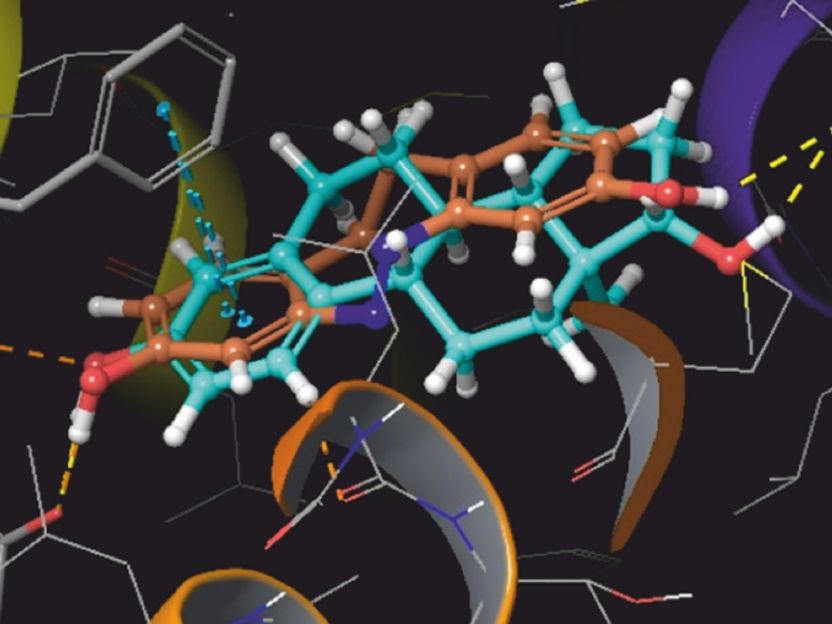Controlling the effect of drugs more precisely
International research team from pharmacy and chemistry develops an estrogen that can be switched on and off
Unwanted side effects in the body, drug resistance or environmentally harmful residues - drugs not only cure diseases or relieve pain, but can also have negative effects on people or the environment. This could be reduced by medical compounds that are only active at the site of an illness in the body. A research team from Pharmacy and Chemistry at Kiel University (CAU), together with colleagues from Barcelona and Glasgow, has now succeeded in developing an estrogen that can be specifically activated by light. In this way, the biological effect of the sex hormone can be limited to an area that is significantly smaller than a cell. The research team recently published their findings in the Journal of the American Chemical Society.

Computer representation of diazocin (brown) and estradiol (light blue) bound in the receptor.
© Herges/Peifer
Hormone residues pollute wastewater
Artificial estrogens are also used as medicines, for example in hormonal contraceptives, for the treatment of breast cancer or against menopausal symptoms. If they get into wastewater, this can affect the hormone balance of fish and other organisms, for example, and ultimately endanger their fertility. "Risks such as drug residues in drinking or waste water have long been known. Another problem with the application of drugs is the damage of neighboring healthy tissue, for example in chemotherapy. Photopharmacology could provide new approaches to this problem," explains Rainer Herges, Professor of Organic Chemistry at CAU.
This relatively new field of research is about developing compounds that can be specifically activated and deactivated by light at different wavelengths – for example, directly at the site of an inflammation or a tumor in the body. The basis for such active compounds are "switchable" molecules, such as diazocines. They change their configuration and thereby their properties when exposed to certain external stimuli.
Limit effects to one cell for the first time
Together with Christian Peifer, Professor of Pharmaceutical Chemistry at CAU, and researchers from the Universities of Glasgow and Ramon Llull in Barcelona, Rainer Herges has now succeeded in producing diazocine molecules whose effect is equivalent to that of estrogens but can be switched on and off with light.
Diazocine molecules show a very high structural similarity to the natural estrogen estradiol. This enables them to dock onto estrogen receptors in certain body tissues and initiate reactions. When they are exposed to blue light with a wavelength of 400 nanometers, their biological effect is switched on, and when they are exposed to green light (530 nanometers), their biological effect is switched off. In its activated form, one of the compounds has an even stronger effect than estradiol, which is considered the most powerful of the natural estrogens.
"But the real 'star' of our study is a molecule that immediately loses its activity after leaving the estrogen receptor. It is only biologically active when it is briefly exposed to light and simultaneously bound to the receptor," Herges emphasizes. The effect of a compound can thus be limited to a size range significantly smaller than a cell. The research groups have thus developed a tool to study the biological activity of a compound with previously unattainable subcellular resolution. "This is a significant step in photopharmacological research - we have already received very much positive feedback from the international scientific community," says Herges.
Light-switchable drugs are already in preclinical testing
"The basic structure of the new molecules may be suitable for developing light-switchable drugs for the treatment of osteoporosis and breast cancer," Peifer gives a possible outlook into the future. Further projects with light-switchable drugs are in preparation. Rainer Herges and other researchers from Barcelona and Kiel have already published a light-controllable substance that can be used to control the activity of individual neurons. However, it will probably take several years before light-controllable drugs are used in clinical practice.
Original publication
Julia Ewert, Linda Heintze, Mireia Jordà-Redondo, Jan-Simon von Glasenapp, Santi Nonell, Götz Bucher, Christian Peifer, and Rainer Herges; Photoswitchable Diazocine-Based Estrogen Receptor Agonists: Stabilization of the Active Form inside the Receptor; J. Am. Chem. Soc. 144, 15059−15071, 2022
Gisela Cabré et al.; Synthetic Photoswitchable Neurotransmitters Based on Bridged Azobenzenes; Org. Lett. 2019





















































